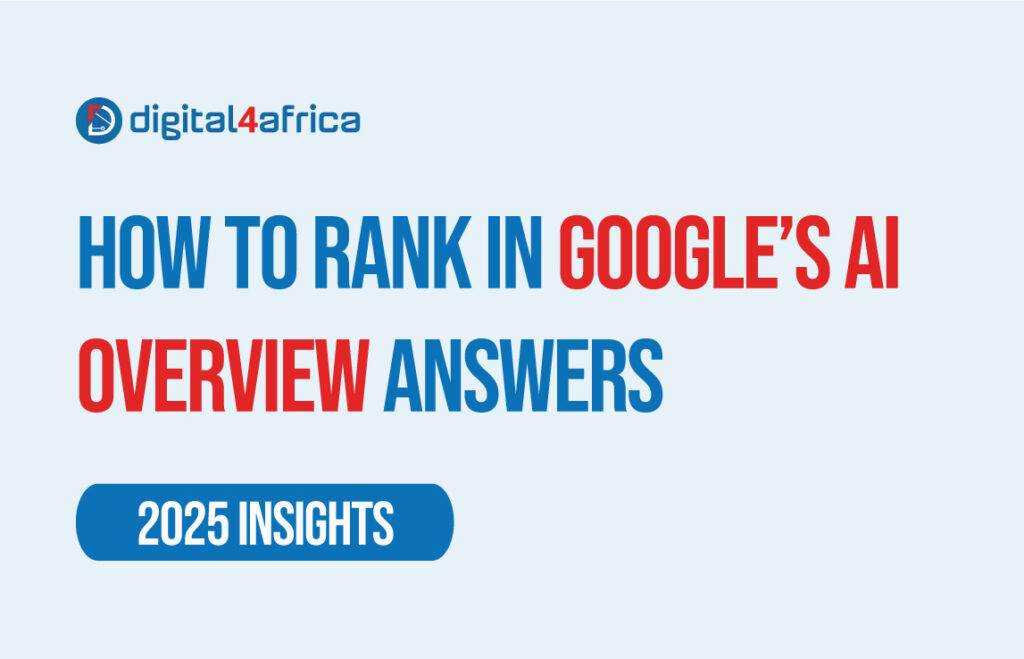How to Rank in Google’s AI Overview Answers Effortlessly | 2025
For the past 22 years, I’ve been deep in the trenches of SEO and digital marketing right here in Kenya, working with fantastic brands and watching the digital landscape transform before our eyes. And let me tell you, the latest transformation – the rise of Generative AI in search, particularly Google’s AI Overviews SEO – is one of the biggest shifts I’ve seen.
You’ve probably noticed them: those summarised answers popping up right at the top of your Google search results, sometimes looking like they’ve read your mind? That’s Google’s AI Overviews in action. And maybe you’ve wondered, “How on earth do I get my business featured there?” or “Is this completely different from the SEO I already know?”
There’s a lot of buzz, maybe even a bit of panic, around this. But don’t worry. While things are changing, the fundamentals of providing value remain. Today, I want to cut through the noise, explain what’s really going on, how optimizing for these AI features (let’s call it Generative Engine Optimization, or GEO) differs from traditional SEO, and give you practical, actionable steps to improve your visibility in this new era.
So, What Exactly Are These AI Overviews?
Think of Google’s AI Overviews as super-smart summaries. When you ask Google a question, especially a complex one, its AI systems might decide to synthesize information from several high-quality web pages to give you a direct, comprehensive answer right there on the results page. It often includes links back to the source pages, but the key difference is that the AI is constructing a new response based on existing content.
While Google is the main focus for most businesses, similar principles apply to how other large language models (like ChatGPT, Perplexity, etc.) might find, interpret, and utilize information from the web if they access it. The core idea is making your content easily understandable and trustworthy for an AI.
This isn’t just a fancy feature; it’s a fundamental shift in how information is surfaced. Being part of that AI-generated answer could become prime real estate for visibility.
Traditional SEO vs. Generative Engine Optimization (GEO): What’s the Real Difference?
This is the million-shilling question, isn’t it? Is GEO just old wine in a new bottle, or is it truly different? The answer is: both. GEO builds heavily on established SEO best practices, but the focus and some tactics are nuanced.
Here’s how I break it down:
The End Goal:
- Traditional SEO: The primary goal has always been to rank your website link as high as possible on the results page (ideally, position 1!). Success is measured by clicks through to your site.
- GEO: The goal shifts towards having your information selected and synthesized by the AI to form part of the overview response. While clicks on the source links within the overview are still valuable, initial visibility comes from being part of the answer itself.
Content Focus:
- Traditional SEO: Focuses on keyword optimization, comprehensive topic coverage, matching search intent, and building topical authority around specific keywords.
- GEO: Requires all of the above, but also demands extreme clarity, direct answers to specific questions within the content, impeccable structure (using headings, lists), and explicit signals of E-E-A-T (Experience, Expertise, Authoritativeness, Trustworthiness) that an AI can easily interpret. It’s less about just containing keywords and more about answering questions clearly and authoritatively.
User Interaction:
- Traditional SEO: Success hinges on enticing the user to click your blue link based on the title tag and meta description.
- GEO: The user might get their primary answer directly from the AI Overview. Your content needs to be compelling and accurate enough to be chosen by the AI and potentially encourage users to click the supporting link for more depth.
An Analogy: Think of traditional SEO like getting your business listed prominently in the phone book (remember those?). GEO is like having the operator directly recommend your business and quote your services when someone calls asking for help. Both require being listed, but the second requires being recognized as a definitive, helpful resource.
Crucially: Don’t throw out your existing SEO playbook! GEO amplifies the need for high-quality content, excellent user experience, technical soundness, and genuine authority. It’s an evolution, adding a layer of optimization focused on AI interpretation.
Your Practical Playbook: How to Optimize for AI Overviews
Alright, let’s get down to brass tacks. How can you, as a business owner or marketer, actually position your website to be favoured by these AI systems?
Double Down on E-E-A-T (It’s Non-Negotiable)
If E-E-A-T (Experience, Expertise, Authoritativeness, Trustworthiness) was important before, it’s paramount now. AI models are designed to prioritize reliable, trustworthy information. You need to scream credibility from the digital rooftops.
Show, Don’t Just Tell:
- Author Bios: Create detailed author pages for your content creators, linking to their credentials (LinkedIn, relevant publications, certifications). Don’t use generic “Admin” authors.
- About Us Page: Make it comprehensive. Detail your company’s history, mission, values, and the real people behind it. Add photos!
- Testimonials & Case Studies: Feature genuine customer reviews and detailed case studies prominently. Make them easy to find.
- Contact Information: Provide clear, easily accessible contact details (physical address if applicable, phone number, email).
Build External Validation:
- Quality Backlinks: Earn links from reputable, relevant websites in your industry. Quality trumps quantity.
- Online Reviews: Encourage happy customers to leave reviews on platforms like Google Business Profile, Yelp, or industry-specific sites. Monitor and respond professionally.
- Secure Your Site: Use HTTPS. It’s a basic trust signal.
- Example: For a client like Nancy Grayson’s healthcare recruitment agency, we’d ensure the ‘Our Team’ page highlights each recruiter’s specific experience in niche healthcare sectors (e.g., “10+ years placing specialized nurses”). We’d also feature testimonials from both hospitals and placed candidates.
Structure Content Like You’re Answering Questions Directly
AI Overviews often trigger for question-based queries. Structure your content to provide clear, direct answers.
- Think Like Your Audience: What specific questions do they have? Use tools like AnswerThePublic, Google’s “People Also Ask” section, Semrush, or Ahrefs to find real user queries.
- Use Headings as Questions: Structure your articles and service pages using H2s and H3s that mirror these questions (e.g., “What are the Side Effects of X Herb?”, “How Long Does Delivery Take to Mombasa?”).
- Provide Concise Summaries: Answer the main question directly and concisely near the beginning of the page or relevant section. AI often looks for these “quick win” answers.
- Create Comprehensive FAQ Pages: Dedicate pages or sections to answering frequently asked questions about your products, services, or industry. This is gold dust for AI.
- Example: For Nancy’s wellness brand, a blog post about Ashwagandha shouldn’t just list facts. It should have sections like “What is Ashwagandha Used For?”, “How Quickly Does Ashwagandha Work?”, “Are There Any Side Effects?”, each providing a clear answer.
Leverage Structured Data (Schema Markup): Speak AI’s Native Language
Schema markup is code you add to your website’s backend that explicitly tells search engines (and AI) what your content is about. It removes ambiguity.
Label Everything: Use schema to identify:
- FAQPage: For your FAQ sections.
- Article: For blog posts (include author, publish date).
- LocalBusiness: Crucial for the wellness space and logistics company (include address, hours, phone).
- Product: For all those herbs, teas, and oils (include price, availability, reviews).
- JobPosting: Essential for the recruitment agency.
- Organization: For your overall business information.
- Person: For author/team member bios.
How to Implement:
You don’t need to be a coding wizard. SEO plugins like Yoast or Rank Math for WordPress have built-in schema features. Google’s Structured Data Markup Helper is another useful tool.
Example:
Adding LocalBusiness schema to the wellness shop’s contact page helps Google AI understand its physical location, opening hours, and phone number, making it more likely to surface that info for local queries.
Write Naturally and Conversationally
AI is getting better at understanding natural human language. Write for humans first!
- Target Long-Tail Keywords: Focus on longer, more specific phrases that mimic how people actually ask questions (e.g., “best natural hair oil for dry scalp in Kenya” vs. just “hair oil”).
- Clarity is King: Use clear, straightforward language. Avoid unnecessary jargon unless your specific audience requires it. Keep sentences and paragraphs relatively concise.
- Readability: Ensure your content flows well and is easy to read. Use formatting like bullet points and short paragraphs.
Don’t Neglect the Technical Fundamentals
Even the best content won’t get picked up if the AI can’t access or process it efficiently.
- Mobile-First: Your site must work perfectly on mobile devices.
- Page Speed: Optimize images, leverage browser caching, and minimize code bloat. Use Google’s PageSpeed Insights to check. Core Web Vitals matter.
- Clean Site Structure: Ensure logical navigation and internal linking so search engines can easily crawl and understand your site’s hierarchy.
- Submit Sitemaps: Keep your XML sitemap updated and submitted via Google Search Console.
Build Authority Beyond Your Website
What others say about you matters.
- Brand Mentions: Monitor mentions of your brand online, even if unlinked.
- Industry Engagement: Participate in relevant online communities or forums (authentically, not spamming!).
- Social Proof: Maintain active and professional social media profiles where relevant to your audience.
A Quick Note on Measuring Success
Measuring direct “rankings” within AI Overviews is tricky right now. Focus on:
- Overall Organic Traffic: Improvements in GEO often lift overall SEO performance.
- Google Search Console: Monitor impressions and clicks. Links within AI Overviews are typically tracked under standard web search performance.
- Keyword Visibility: Track rankings for your target question-based and long-tail keywords.
- Qualitative Checks: Regularly search for your core topics and questions to see if AI Overviews appear and if your site (or competitors) are being cited.
The Takeaway: Embrace the Evolution
Optimizing for Generative AI Overviews isn’t about chasing a fleeting algorithm trick. It’s about doubling down on what truly matters: creating high-quality, authoritative, user-focused content that is clearly structured and technically sound.
It requires a slight shift in perspective – thinking less about just ranking a link and more about becoming a trusted source whose information is worthy of being directly incorporated into an AI’s answer.
Yes, it requires effort. But by focusing on these principles, you’re not just optimizing for AI; you’re building a better, more valuable website for your human audience too. And in the long run, that’s always the winning strategy.
Let’s navigate this exciting new chapter in search together! If you have questions, feel free to reach out to us at Digital For Africa LTD. We’re always happy to chat about bringing your digital presence to the forefront.
By Francis Waithaka, Founder and CEO, Digital4Africa.


